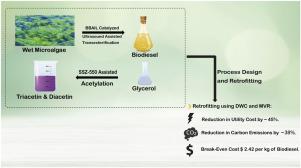Chemical Engineering Research and Design ( IF 3.9 ) Pub Date : 2021-05-19 , DOI: 10.1016/j.cherd.2021.05.010 Savyasachi Shrikhande , Gunavant Deshpande , Ashish N. Sawarkar , Z. Ahmad , Dipesh S. Patle

|
Although biodiesel synthesis has been widely studied, the use of wet microalgal feedstock for biodiesel synthesis using ionic liquid catalyst and ultrasonication is scarce to find, especially pertaining to economic viability and environmental impact. In this study, new processes are designed based on the experimental results for ultrasound assisted in situ algal biodiesel production using an ionic liquid catalyst. Process retrofitting is then conducted using a divided-wall column (DWC) and multistage vapor recompression (MVR). Later, comparative analyses in terms of capital cost, cost of manufacturing (COM), cost of biodiesel, specific energy consumption (SEC) and carbon emission is presented. The process with DWC and MVR resulted in a significant saving in COM (13.84%), biodiesel cost (18.24%), utility cost (45.44%), SEC (29.15%) and carbon emissions (38.15%) than those in its counterpart. This study shows that the biodiesel cost is linearly dependent on the cost of feedstock and process economics can be improved by converting glycerol to triacetin. Major contributions of this work are (1) experimental and process design for a novel ultrasound assisted and ionic liquid catalyzed algal biodiesel production, (2) retrofitting using DWC and MVR and (3) investigation of the uncertainty in the thermodynamic property. This study is significant as it designs processes based on the experimental outcomes and investigates designs for their economic as well as environmental merits.
中文翻译:

超声强化和离子液体催化原位藻类生物柴油生产的设计与改造
尽管已经对生物柴油合成进行了广泛的研究,但很少发现使用湿微藻原料在使用离子液体催化剂和超声处理的生物柴油合成中,特别是在经济可行性和环境影响方面。在这项研究中,基于实验结果设计了新工艺,以利用离子液体催化剂超声辅助原位藻类生物柴油生产。然后,使用隔壁塔(DWC)和多级蒸气再压缩(MVR)进行工艺改造。随后,提出了在资本成本,制造成本(COM),生物柴油成本,比能源消耗(SEC)和碳排放方面的比较分析。使用DWC和MVR的过程可显着节省COM(13.84%),生物柴油成本(18.24%),公用事业成本(45.44%),SEC(29。15%)和碳排放量(38.15%)。这项研究表明,生物柴油的成本与原料成本成线性关系,并且可以通过将甘油转化为三醋精来提高工艺经济性。这项工作的主要贡献是(1)新型超声辅助和离子液体催化藻类生物柴油生产的实验和工艺设计,(2)使用DWC和MVR进行改造,以及(3)研究热力学性质的不确定性。这项研究意义重大,因为它根据实验结果设计流程,并针对其经济和环境优点调查设计。这项研究表明,生物柴油的成本与原料成本成线性关系,并且可以通过将甘油转化为三醋精来提高工艺经济性。这项工作的主要贡献是(1)新型超声辅助和离子液体催化藻类生物柴油生产的实验和工艺设计,(2)使用DWC和MVR进行改造,以及(3)研究热力学性质的不确定性。这项研究意义重大,因为它根据实验结果设计流程,并针对其经济和环境优点调查设计。这项研究表明,生物柴油的成本与原料成本成线性关系,并且可以通过将甘油转化为三醋精来提高工艺经济性。这项工作的主要贡献是(1)新型超声辅助和离子液体催化藻类生物柴油生产的实验和工艺设计,(2)使用DWC和MVR进行改造,以及(3)研究热力学性质的不确定性。这项研究意义重大,因为它根据实验结果设计流程,并针对其经济和环境优点调查设计。(2)使用DWC和MVR进行改造,以及(3)研究热力学性质的不确定性。这项研究意义重大,因为它根据实验结果设计流程,并针对其经济和环境优点调查设计。(2)使用DWC和MVR进行改造,以及(3)研究热力学性质的不确定性。这项研究意义重大,因为它根据实验结果设计流程,并针对其经济和环境优点调查设计。


























 京公网安备 11010802027423号
京公网安备 11010802027423号